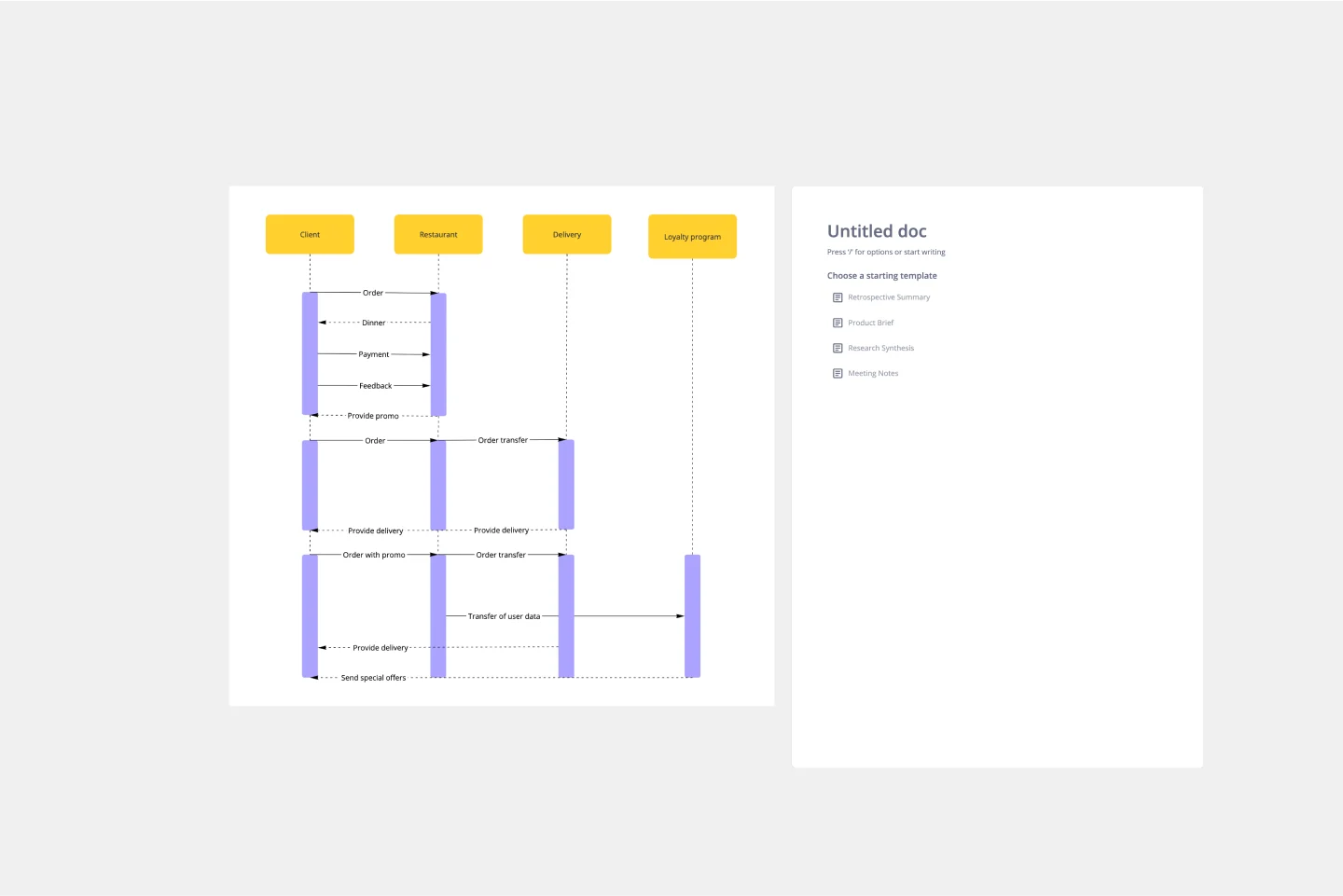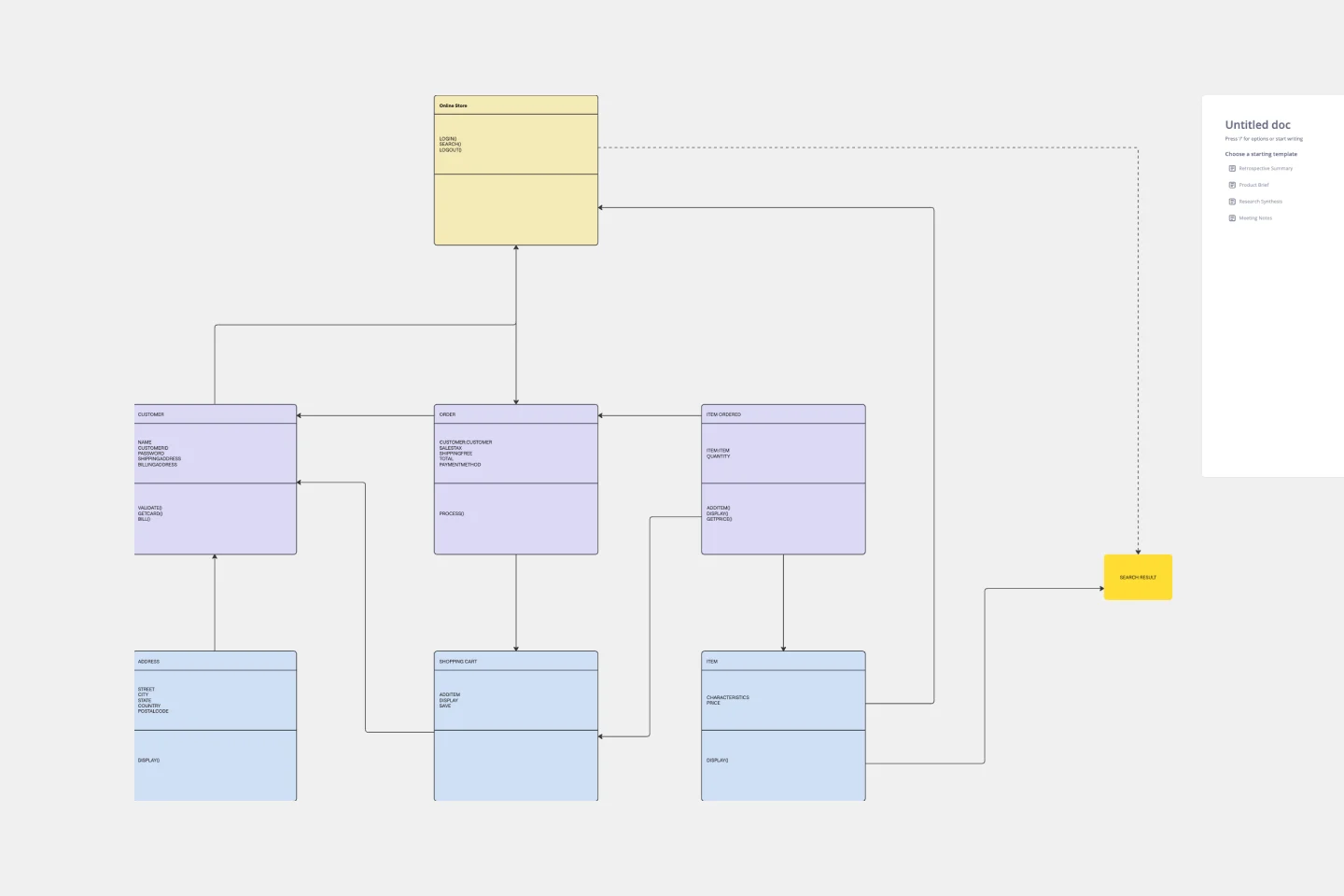About the UML Sequence E-commerce Checkout Template
The UML Sequence E-commerce Checkout Template streamlines the visualization of the e-commerce checkout process. This template provides a step-by-step visual representation of the interactions between different components or objects within an e-commerce system during the checkout journey. From adding an item to the cart to processing the payment, it meticulously outlines who communicates with whom and when ensuring a clear understanding of the flow of control and the order of events. This template is an invaluable asset for teams looking to document and analyze the checkout process, facilitating a smoother and more efficient workflow.
How to use the UML Sequence E-commerce Checkout Template
Customize it: Once you have selected the UML Sequence E-commerce Checkout Template, begin editing it to fit your specific needs. Use the UML shapes and features to tailor the template or even create a diagram from scratch.
Collaborate: Modify the diagram with your team in real time or asynchronously, reviewing everything together in one workspace.
Review and iterate: As Miro boards update in real-time, you and your team can quickly create UML diagrams. This dynamic environment supports continuous improvement, allowing you to iterate on the diagram as needed based on team feedback or changes in the checkout process.
Why use the UML Sequence E-commerce Checkout Template
Using the UML Sequence E-commerce Checkout Template in Miro has several benefits:
Clarity: It provides a clear visual representation of the checkout process, making it easier to understand the interactions between different system components over time.
Efficiency: The template accelerates the documentation process, enabling teams to visualize and analyze the checkout flow quickly.
Collaboration: Miro’s collaborative environment allows team members to work together seamlessly, whether they are in the same room or distributed across the globe. This fosters a collective understanding and facilitates the identification of potential improvements or issues within the checkout process.
Customization: With Miro’s comprehensive set of tools and features, the template can be easily customized to meet the unique needs of your project or organization.
Adaptability: The UML Sequence E-commerce Checkout Template is highly adaptable, making it suitable for a wide range of e-commerce platforms and checkout processes. Whether you're dealing with simple direct sales or complex transactions involving multiple parties and services, the template can be tailored to fit your specific scenario.
Problem-solving: The template provides a visual representation of the checkout process, helping to identify bottlenecks, inefficiencies, or potential errors within the system. This proactive approach to problem-solving can lead to a more streamlined and error-free checkout experience for customers.
Documentation and communication: The template serves as an excellent documentation tool, capturing the intricate details of the e-commerce checkout process in a format that's easy to understand and communicate. This can be particularly useful for onboarding new team members, sharing plans with stakeholders, or communicating with external partners.
Innovation and improvement: With a clear understanding of the current checkout process, teams are better positioned to innovate and make improvements. The template can inspire new ideas for enhancing efficiency, user experience, or security, ultimately contributing to the growth and success of the e-commerce platform.

Miro
Your virtual workspace for innovation
Miro is an innovation workspace designed for teams of every size, everywhere, to dream, design, and build the future together. Our mission? To empower these teams to create the next big thing, powered by AI at every step of the way. Over 90 million users around the world rely on Miro to untangle complex ideas, put customer needs first, and deliver products and services faster. All supported by best-in-class security, compliance, and scalability.
Categories
Similar templates
UML Sequence Diagram Template

UML Sequence Diagram Template
Analyze and showcase how external entities interact with your system using a sequence diagram. Get a bird’s-eye view of your work processes, business functions, and customer interactions using this diagram. Also, identify any potential problems early and solve them before implementation.
UML Diagram Template

UML Diagram Template
Originally used as a modeling language in software engineering, UML has become a popular approach to application structures and documenting software. UML stands for Unified Modeling Language, and you can use it to model business processes and workflows. Like flowcharts, UML diagrams can provide your organization with a standardized method of mapping out step-by-step processes. They allow your team to easily view the relationships between systems and tasks. UML diagrams are an effective tool that can help you bring new employees up to speed, create documentation, organize your workplace and team, and streamline your projects.
UML Class Diagram Template

UML Class Diagram Template
Get a template for quickly building UML class diagrams in a collaborative environment. Use the UML class diagram template to design and refine conceptual systems, then let the same diagram guide your engineers as they write the code.
UML Sequence Diagram Template

UML Sequence Diagram Template
Analyze and showcase how external entities interact with your system using a sequence diagram. Get a bird’s-eye view of your work processes, business functions, and customer interactions using this diagram. Also, identify any potential problems early and solve them before implementation.
UML Diagram Template

UML Diagram Template
Originally used as a modeling language in software engineering, UML has become a popular approach to application structures and documenting software. UML stands for Unified Modeling Language, and you can use it to model business processes and workflows. Like flowcharts, UML diagrams can provide your organization with a standardized method of mapping out step-by-step processes. They allow your team to easily view the relationships between systems and tasks. UML diagrams are an effective tool that can help you bring new employees up to speed, create documentation, organize your workplace and team, and streamline your projects.
UML Class Diagram Template

UML Class Diagram Template
Get a template for quickly building UML class diagrams in a collaborative environment. Use the UML class diagram template to design and refine conceptual systems, then let the same diagram guide your engineers as they write the code.